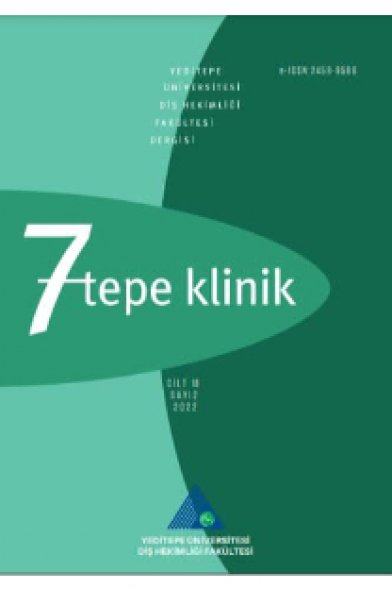Prosthetic restoration types of dental implants
Dental implantların protetik restorasyon tipleri
___
- National Library of Medicine - Medical Subject Head- ings, 2013, http://www.nlm.nih.gov/cgi/mesh/2013/MB_ cgi?mode=&term=Tooth+Loss&field=entry
- Sunnegardh-Gronberg K, Davidson T, Gynther G, Jemt T, Lekholm U, Nilner K, Nordenram G, Norlund A, Rohlin M, Tranaeus S, Hultin M. Treatment of adult patients with partial edentulism: a systematic review. Int J Prosthodont ;25:568-581.
- Vogel R, Smith-Palmer J, Valentine W. Evaluating the health economic implications and cost-effectiveness of dental implants: a literature review. Int J Oral Maxillofac Implants 2013;28:343-356.
- Rohlin M, Nilner K, Davidson T, Gynther G, Hultin M, Jemt T, Lekholm U, Nordenram G, Norlund A, Sunneg- ardh-Gronberg K, Tranaeus S. Treatment of adult patients with edentulous arches: a systematic review. Int J Prost- hodont 2012;25:553-567.
- Salinas TJ, Eckert SE. In patients requiring single-tooth replacement, what are the outcomes of implant- as com- pared to tooth-supported restorations? Int J Oral Maxillo- fac Implants 2007;22 Suppl:71-95.
- Ozkurt Z, Kazazoğlu E. Treatment modalities of sin- gle-tooth missing in a Turkish subpopulation: Im- plant, fixed partial denture or no restoration. J Dent Sci ;5:183-188.
- Jung RE, Pjetursson BE, Glauser R, Zembic A, Zwahlen M, Lang NP. A systematic review of the 5-year survival and complication rates of implant-supported single crowns. Clin Oral Implants Res 2008;19:119-130.
- Pjetursson BE, Bragger U, Lang NP, Zwahlen M. Com- parison of survival and complication rates of tooth-sup- ported fixed dental prostheses (FDPs) and implant-sup- ported FDPs and single crowns (SCs). Clin Oral Implants Res 2007;18:97-113.
- Misch CE. Dental implant prosthetics. St. Louis: Mosby, Bryant SR, MacDonald-Jankowski D, Kim K. Does the type of implant prosthesis affect outcomes for the com- pletely edentulous arch? Int J Oral Maxillofac Implants ;22 Suppl:117-139.
- Krennmair G, Seemann R, Fazekas A, Ewers R, Pie- hslinger E. Patient preference and satisfaction with im- plant-supported mandibular overdentures retained with ball or locator attachments: a crossover clinical trial. Int J Oral Maxillofac Implants 2012;27:1560-1568.
- Feine JS, Carlsson GE, Awad MA, Chehade A, Dun- can WJ, Gizani S, Head T, Lund JP, MacEntee M, Meric- ske-Stern R, Mojon P, Morais J, Naert I, Payne AG, Penrod J, Stoker GT, Tawse-Smith A, Taylor TD, Thomason JM, Thomson WM, Wismeijer D. The McGill consensus state- ment on overdentures. Mandibular two-implant overden- tures as first choice standard of care for edentulous pa- tients. Int J Oral Maxillofac Implants 2002;17:601-602.
- Attard NJ, Zarb GA. Long-term treatment outcomes in edentulous patients with implant overdentures: the To- ronto study. Int J Prosthodont 2004;17:425-433.
- Ellis JS, Burawi G, Walls A, Thomason JM. Patient sat- isfaction with two designs of implant supported remov- able overdentures; ball attachment and magnets. Clin Oral Implants Res 2009;20:1293-1298.
- Ozkurt Z, Dikbas I, Kazazoglu E. Predoctoral prostho- dontic clinical curriculum for complete dentures: survey in Turkish dental schools. J Dent Educ 2013;77:93-98.
- King NM, Shaw L, Murray JJ. Caries susceptibility of permanent first and second molars in children aged 5-15 years. Community Dent Oral Epidemol 1980;8:151-158.
- Han JY, Jung GU. Labial and lingual/palatal bone thickness of maxillary and mandibular anteriors in hu- man cadavers in Koreans. J Periodontal Implant Sci ;41:60-66.
- McCaul LK, Jenkins WM, Kay EJ. The reasons for the extraction of various tooth types in Scotland: a 15-year follow up. J Dent 2001;29:401-407.
- Glauser R, Ree A, Lundgren A, Gottlow J, Hammerle C, Scharer P. Immediate occlusal loading of Branemark implants applied in various jawbone regions: a prospec- tive, 1-year clinical study. Clin Implant Dent Relat Res ;3:204-213.
- Degidi M, Piattelli A, Gehrke P, Felice P, Carinci F. Five year outcome of 111 immediate nonfunctional single restaurations. J Oral Implantol 2006;32:277-285.
- Mericske-Stern R: Clinical evaluation of overdenture restorations supported by osseointegrated titanium im- plants: A retrospective study. Int J Oral Maxillofac Im- plants 1990;5:375-383.
- Zarb GA, Schmitt A: The longitudinal clinical effec- tiveness of osseointegrated dental implants: The Toron- to study. Part II: The prosthetic results. J Prosthet Dent ;64:53-61.
- Johns RB, Jemt T, Heath MR, et al: A multicenter study of overdentures supported by Brånemark implants. Int J Oral Maxillofac Implants 1992;7:513-522.
- Carlsson GE, Omar R. The future of complete den- tures in oral rehabilitation. A critical review. J Oral Rehabil ;37:143-156.
- Burns DR, Unger JW, Elswick RK, et al: Prospective clinical evaluation of mandibular implant overdentures. Part I: Retention, stability and tissue response. J Prosthet Dent 1995;73:354-363.
- Celik G, Uludag B.Photoelastic stress analysis of var- ious retention mechanisms on 3-implant-retained man- dibular overdentures. J Prosthet Dent 2007;97:229-235.
- Burns DR. Mandibular implant overdenture treatment: consensus and controversy. J Prosthodontics 2000;9:37
- Tallgren A. The continuing reduction of the residual alveolar ridges in complete denture wearers: a mixed-lon- gitudinal study covering 25 years. J Prosthet Dent ;27:120-132.
- Van Waas MA. The influence of clinical variables on patients' satisfaction with complete dentures. J Prosthet Dent 1990;63:307-310.
- ISSN: 2458-9586
- Yayın Aralığı: 3
- Başlangıç: 2005
- Yayıncı: Yeditepe Üniversitesi Rektörlüğü
Prosthetic restoration types of dental implants
Zeynep KAYAHAN ÖZKURT, Ender KAZAZOĞLU
A methodological study on improving a new orthodontic face mask
NURHAT ÖZKALAYCI, MEHMET YETMEZ
Evaluation of different instrumentation systems for apical extrusion of debris
RECAİ ZAN, HÜSEYİN SİNAN TOPÇUOĞLU, İHSAN HUBBEZOĞLU, JALE TANALP, Meric KAZANDAĞ KARAPINAR
Multidisciplinary treatment for a young patient with severe bone loss from a trauma: A case report
Berkay Tolga SÜER, CUMHUR KORKMAZ
Classification and current treatment options of endo-perio lesions
GİZEM İNCE KUKA, Güher BARUT, HARE GÜRSOY
Endodontik-periodontal lezyonlu mandibular moların kombine tedavisi: Bir olgu sunumu
Fatma KANMAZ, Turan Emre KUZU, RECAİ ZAN, DEMET ALTUNBAŞ
Diş renkleşmeleri ve beyazlatma tedavileri
Zümrüt Ceren ÖZDUMAN, Çiğdem ÇELİK
Partial edentulism and treatment options
Zeynep KAYAHAN ÖZKURT, Ceyda TOMRUK ÖZÇAKIR, Ender KAZAZOĞLU
